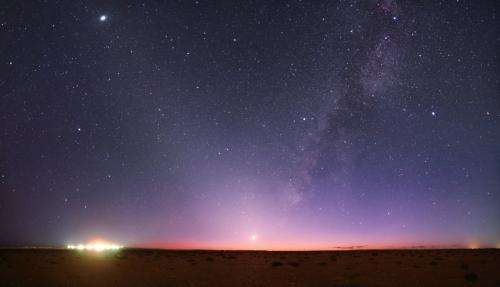Zodiacal light scattered from dust grains in our solar system is seen rising diagonally up to the left in this image, as the plane of the Milky Way rises up to the right. Scientists have used the STEREO spacecraft to study tiny nanodust particles in the solar system. Credit: Tunc Tezel, TWAN; APOD
(Phys.org) —In our solar system, dust particles are abundant, created by asteroid collisions and by the evaporation of comets. These particles are the source of the zodiacal light, a diffuse glow in the night sky that extends along the ecliptic (the plane of the solar system) and which is seen from Earth stretching along the zodiac, most easily after sunset or before sunrise. It is so faint that moonlight is enough to mask it.
The gravity of the planets affects the distribution of these dust particles. The Earth, for example, collects dust in a series of patches which lie in a ring along the Earth's orbit. New measurements used radio instruments on twin interplanetary spacecraft to study nanometer-scale dust particles, or "nanodust." A grain of nanodust is smaller than a wavelength of optical light, and unlike the roughly ten times larger grains responsible for the zodiacal light, nanodust is too small to efficiently scatter sunlight and can only be detected using space instruments. When a grain of nanodust impacts a spacecraft, it creates an expanding cloud of ionized gas which can lead to a voltage pulse between a spacecraft's body and its antenna, and which can then be sensed. Nanodust can be accelerated by the interplanetary magnetic field to the speed of the solar wind—significantly faster than the orbital speeds of heavier dust grains. Because the electrical signal induced by a dust grain depends more strongly on its impact speed than on its mass, nanodust produces a strong signal despite its being lightweight.
CfA astronomers Gaetan Le Chat and Justin Kasper, along with eight colleagues, used the Low Frequency Receiver onboard the twin Solar TErrestrial RElations Observatory (STEREO) spacecraft in an extensive program spanning seven years to deduce the characteristics of nanodust. The two STEREO spacecraft are in solar orbits with one ahead of the Earth and one trailing behind. On average, the spacecraft recorded about fifty nanodust impacts (voltage pulses) every second, with occasional bursts of up to a thousand hits. The scientists analyzed over seven hundred thousands measurements to conclude that nanodust is a significant contributor to the total mass of material in interplanetary space, in agreement with earlier estimates, and to begin to characterize its properties. Although STEREO was designed to study solar storms, not nanodust, the new results not only help complete the picture of our solar system, they show how innovative scientists can sometimes squeeze added science from workhorse instruments.
More information: Le Chat, G. et al. Interplanetary Nanodust Detection by the Solar Terrestrial Relations Observatory/WAVES Low Frequency Receiver, Solar Physics, 286, 549, 2013.
Journal information: Solar Physics
Provided by Harvard-Smithsonian Center for Astrophysics
























